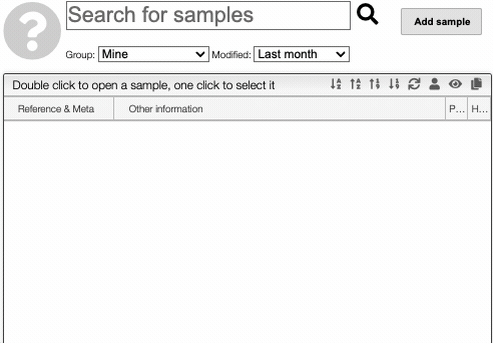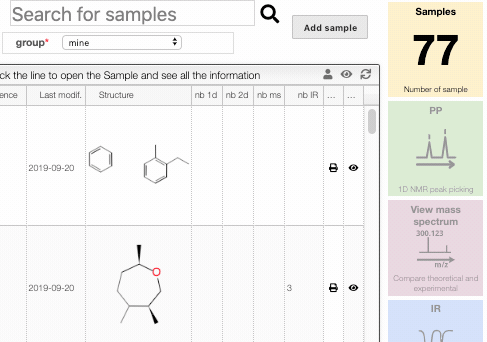Homepage
The Home page looks like above. The general structure is the following:
- Tabs containing different tools you can use
- Panel with the tools at your disposal
- Help button bringing you to the manual
- Sample search panel and group filter
- Sample overview panel
- Information about selected sample
If you have selected a sample, you can select a tab in the section 1 and then select a tool in the section 2.

This platform allows you to organize the information about your samples, including the spectral, physical and chemical data. Furthermore, you can employ various algorithms to test and simulate certain properties, like chemical shifts and Lipinski's criteria. The Electronic Lab Notebook (ELN) allows you to store the protocols of your procedures, maintain information about reactions and efficiently write reports.
How to use it
To store your samples you must first log in with your Google account (upper-right corner). Public samples are available without login. You can either create your own sample and have access and edit its information at any time, or search for information about a sample created by a member of a group you belong to. The groups filter the samples according to ownership and allow you to share data with your coworkers only.
Once the sample is created, you may add experimental information, like spectra, and then manipulate it using the available tools.
Tool set
To the right of the List of selected samples you find the tool set. Clicking on a tool icon will take you to a new tab where you can perform additional tasks (e.g. structure search, structural analysis, 3D modelling). If you wish to find out more, additional information is available further in the manual.
Search
From the homepage it is possible to quickly find samples using the Search for sample query box.
In this box you may simply enter a text and the system will look in the following fields:
- Reference
- Names and description
- Molecular formula
- Keywords
It is also possible to target a specific field by using as syntax: <fieldName>:<operator><value>
The following fields are allowed:
nbNmr,nb1d,nb2d,nb13c,nb1h: number of spectrum registered for NMR, 1d NMR...nbMass,nbIR,nbTGA,nbDSC,nbRaman,nbMass,nbUV,nbXray: number of spectrum registered for IR, Raman ...mf,mw,em: molecular formula, molecular weight and exact mass (monoisotpic mass)title: title of the sample.meta: meta information.owner: name of the owner.modified: last modification date of the sample.created: creation date of the sample.
The space between search elements is interpreted as an AND operator. The operators in the research field can be: <, > or = (= None).
Some examples:
nb1d:>0: all the samples that have at least one 1D NMR spectrummw:>100 mw:<150: all samples with molecular weight between 100 and 150jacs: all the sample that containsjacsin any of the fields (reference, names, ...)mf:C10: all the sample that have a MF that containsC10(string search)modified:>2021-04-11 modified:<2021-04-14 owner:justyna: all samples that are owned by "justyna" and where modified between April, 11 2021 and April, 14 2021
Filters
You can apply filters in the two dropdown selectors: the first one corresponds to the owner of the sample, you can choose Mine, All or Anonymous Read (used to manipulate product even if not logged in). The second one gives the last modify time: you can choose between the last month and the last 5 years, or at any time.

Sample panel
In the sample overview panel, you can sort the element by clicking on one of the icon in the menu bar: .
The first three buttons are used for sorting the sample by: product code, reverse product code, modification date or reverse modification date. You can also refresh the list, see user informations, hide and show samples and copy the table of content.
Meta
A product is allowed to have an unlimited number of meta information. Meta information is characterized by a property followed by a value. The name of the property is searchable in the quick search.
For example if you add a meta information having as property 'country' you may search using 'country:colombia'.
Hide/Show sample
In order to hide a sample you may click on the eye icon on the sample line.
You have the possibility to display all the hidden samples by clicking on the eye on the
top of the box. From that list you can then unhide a sample if you need.

